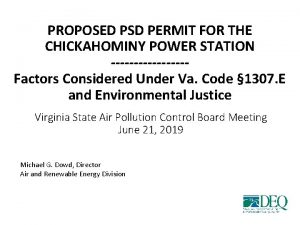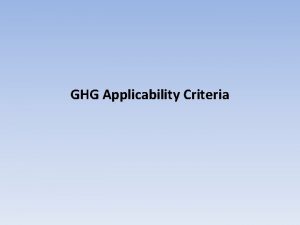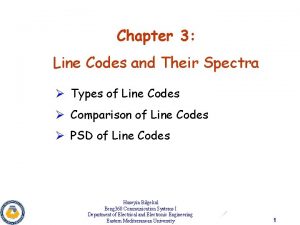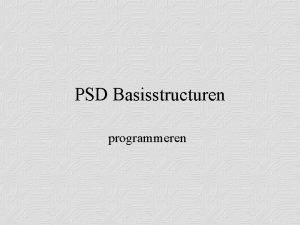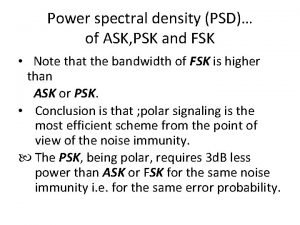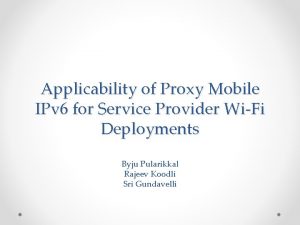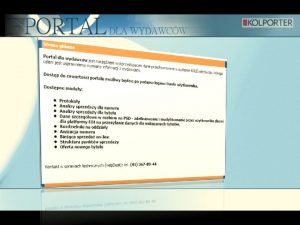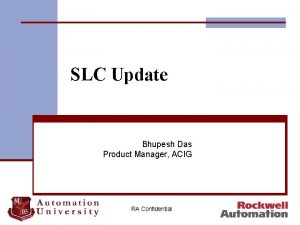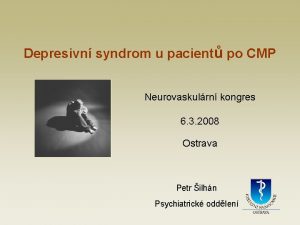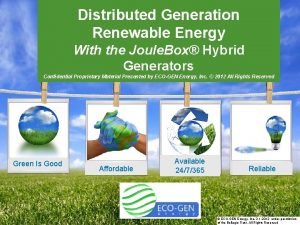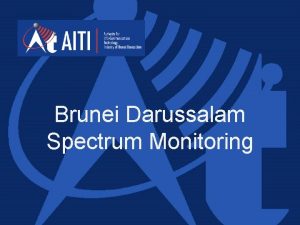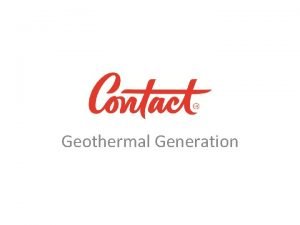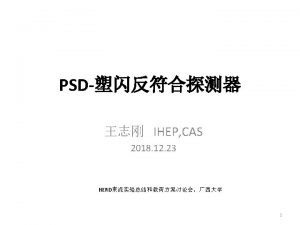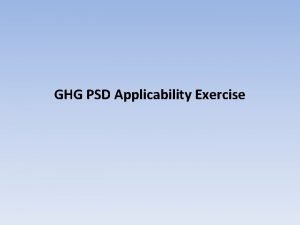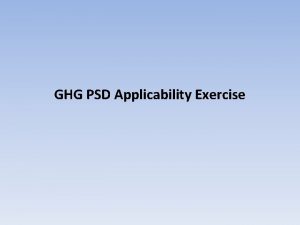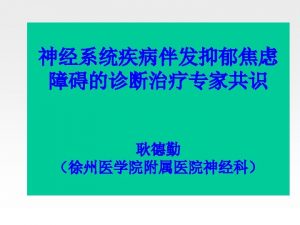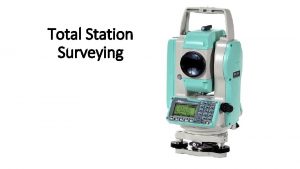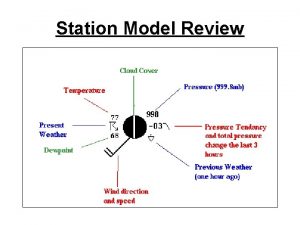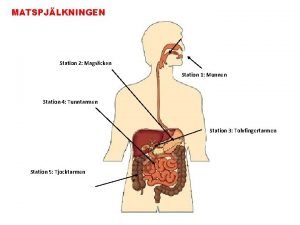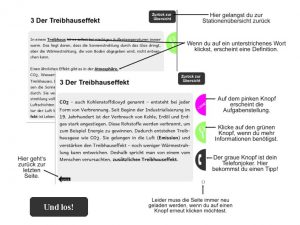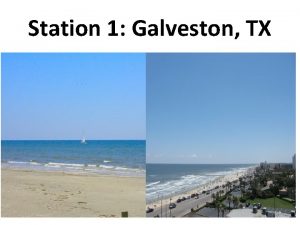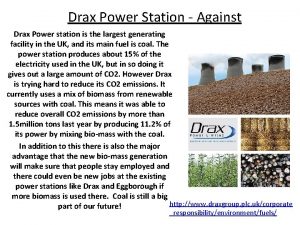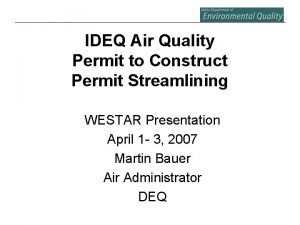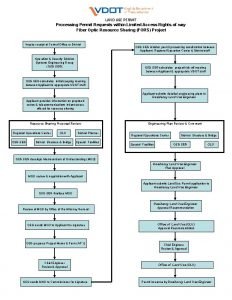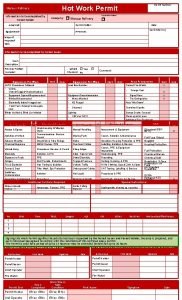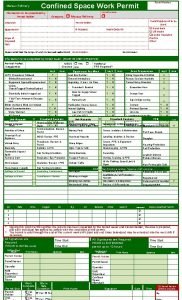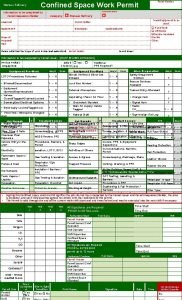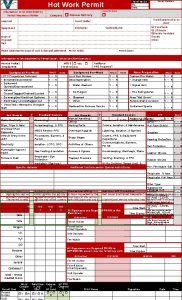PROPOSED PSD PERMIT FOR THE CHICKAHOMINY POWER STATION


































- Slides: 34

PROPOSED PSD PERMIT FOR THE CHICKAHOMINY POWER STATION --------Factors Considered Under Va. Code § 1307. E and Environmental Justice Virginia State Air Pollution Control Board Meeting June 21, 2019 Michael G. Dowd, Director Air and Renewable Energy Division

Protection of Public Health and the Environment are DEQ’s Most Important Goals ALL Virginia air permits require • State-of-the-art air pollution control • Assurance that the facility will not cause any violation of health-based air quality standards o National Ambient Air Quality Standards o State air toxics standards 2

National Ambient Air Quality Standards • The Clean Air Act requires EPA to set NAAQS at a level to protect public health with an ample margin of safety o Based on most current health science o Key components include Integrated Science Assessment (ISA) and Risk/Exposure Assessment (REA) o Participation by outside health science experts o Must protect sensitive populations, such as the young, the elderly and asthmatics • NAAQS established for ozone, nitrogen dioxide, lead, sulfur dioxide, carbon monoxide, and for PM 10 and PM 2. 5 sized particulate matter • Reviewed by EPA every five years o PM 2. 5 NAAQS currently under review by EPA with proposed rulemaking expected in 2020 3

Va. Code § 1307 E The Board in making regulations and in approving variances, control programs, or permits, and the courts in granting injunctive relief under the provisions of this chapter, shall consider facts and circumstances relevant to the reasonableness of the activity involved and the regulations proposed to control it, including: 1. The character and degree of injury to, or interference with, safety, health, or the reasonable use of property which is caused or threatened to be caused; 2. The social and economic value of the activity involved; 3. The suitability of the activity to the area in which it is located; and 4. The scientific and economic practicality of reducing or eliminating the discharge resulting from such activity. 4

Va. Code § 1307 E. 1 and 4 • The first and fourth factors -1. The character and degree of injury to, or interference with, safety, health, or the reasonable use of property which is caused or threatened to be caused 4. The scientific and economic practicality of reducing or eliminating the discharge resulting from such activity • Satisfied by DEQ’s analysis and permit requirement that Chickahominy Power Station (CPS) o Apply Best Available Control Technology (BACT) o Assure that emissions under worst case circumstances do not violate health-based air quality standards 5

Proposed Chickahominy Power Station Pollution Control Technology & Emission Limits Best Available Control Technology, or “BACT” • NOx - Selective Catalytic Reduction down to 2 parts per million (ppm) • CO - Oxidation Catalyst down to 1. 0 ppm • VOC - Oxidation Control down to 0. 7 ppm • PM 10, PM 2. 5, and, SO 2 - low sulfur fuel and good combustion practices • GHG - Highly efficient turbine design and operations resulting in CO 2 – e emissions ranging from 812 to 871 Ib/MWh over the life of the facility • LDAR for components leaking methane 6

Air Modeling • Computer modeling completed using the worst case scenario for each pollutant • Chickahominy Power Station’s emissions will not violate any EPA health-based National Ambient Air Quality Standard (NAAQS) • Those emissions will not violate state air toxics standards 7

Va. Code § 1307 E. 2 and 3 • The second and third factors require consideration of 2. The social and economic value of the activity involved, and 3. The suitability of the activity to the area in which [the proposed facility] is located when issuing air permits 8

Social, Economic Value, and Site Suitability Factors considered by DEQ • Charles City County Board of Supervisors Special Use Permit and Dept. of Planning Staff Report • State Corporation Commission (SCC) Final Order granting Certificate of Public Convenience and Necessity (CPCN) • EJSCREEN Analysis • Public comments o Chickahominy Indian Tribe 9

Local Zoning Authority • Va. Code § 15. 2 -2200 et seq. , confers zoning authority on local jurisdictions o Encourage localities to improve the public health, safety, convenience and welfare of citizens and take into consideration needs of agriculture, industry and business in future development • 15. 2 -2212 requires planning commissioners to be residents of the locality, qualified by knowledge and experience to make decisions on community growth and development • 15. 2 -2280 provides localities may regulate and determine the use of land, buildings and structures for agricultural, business, industrial, residential and other specific uses 10

Charles City County Dept. of Planning Staff Report and Special Use Permit • Dept. of Planning Staff Report issued May 6, 2015 o CPS consistent with county’s Comprehensive Plan o Consistent with county’s draft Economic Development Plan citing energy sector potential • Charles City County Planning Commission and Board of Supervisors approved SUP unanimously on May 28, 2015 o Subsequently modified three times; most recently on November 22, 2016 • Only one public comment through four public hearings • Certification received by DEQ on February 22, 2017 o Air permit cannot be issued without local approvals 11

Charles City County Special Use Permit The Chickahominy Power Station’s Special Use permit contains 29 conditions • County Site Plan Ordinance ¶ 2 • Right of inspection ¶ 8 • Light ¶¶ 9 -10 • Parking, fencing, signage, landscaping, and set-backs ¶¶ 11 -14 • Traffic and paving ¶¶ 15 -18 • County E&S and Stormwater Management Plan controls ¶ 19 • Noise ¶ 24 12

State Corporation Commission Certificate of Public Convenience and Necessity • Entities seeking to build and operate an electric generation facility must obtain a CPCN from the SCC in accordance with Title 56 of the Virginia Code • Code §§ 56 -580, 56 -265. 2, 56 -46. 1, and 56 -596 set forth legal standards the SCC must apply when deciding whether to issue a CPCN, which address among other things: o The need for electric generation o Service reliability o Environmental impact o The public interest o Economic development in the Commonwealth 13

State Corporation Commission Certificate of Public Convenience and Necessity • Public hearing held on March 26, 2018 o Charles City County Supervisor and Administrator testified in favor of project • Roxbury Industrial Corridor site is suitable; away from historic and environmentally sensitive areas of county • Significant positive economic impact in terms of job growth, potential additional development , and increased tax base o Letter of support from Chickahominy Tribe o No adverse witnesses or testimony • Hearing Examiner’s report recommending granting of CPCN issued April 13, 2018 • SCC Final Order approving CPCN issued May 8, 2018 finding CPS met all applicable criteria 14

State Corporation Commission Findings The Commission found the benefits of the facility included • Enhancing the reliability of electric supply in the state and PJM region, particularly during peak demand times • Enhancing the competitive market for wholesale electricity in the region by offering generation that would not be owned by an incumbent regulated electric utility o Business risk borne solely by CPS and its investors • Providing substantial economic benefits to Charles City County while imposing little or no negative economic impact on county or state o Substantial number of temporary construction jobs and new permanent jobs in county o Millions of dollars increase in local and state tax revenues annually 15

Environmental Justice • “The fair and meaningful involvement of all people regardless of race, color, faith, national origin, or income in the development, implementation, and enforcement of environmental laws, regulations, and policies” o Executive Order 29 (1/22/19), superseding EO-73 (2017) • Objective of the Commonwealth to develop “energy resources and facilities in a manner that does not impose a disproportionate adverse impact on economically disadvantaged or minority communities” o Va. Code 67 -101. 12 • “DEQ’s existing obligations to ensure that all regulated entities comply with health-based standards will continue in all permitting activities to reduce public health burdens on all populations” o 2018 Virginia Energy Plan, p. 58 16

Environmental Justice Factors considered by DEQ o Pollution control technology review • State of the art pollution controls o Air modeling • Assures no exceedances of health based ambient air concentration standards o EJSCREEN o Public comments o Emissions source inventory for surrounding area o Outreach • • • Pubic hearing Question & answer session Reached out to all Indian tribes in eastern Virginia Meeting with Chickahominy Indian Tribe leaders CPS outreach efforts 17

EJSCREEN • EJSCREEN developed by EPA as an environmental justice mapping and screening tool with nationally consistent dataset and approach for combining environmental and demographic indicators • Incorporates recommendations from National Environmental Justice Advisory Council (NEJAC) • Should be used only as screening tool and indicator if further investigation warranted 18

EJSCREEN Six Demographic Indicators • Percent low income o Less than/equal twice federal poverty level • Percent minority o Other than single-race non-Hispanic white • Less than high school education o Percent over age 25 w/o • Linguistic isolation • Individuals under age 5 • Individuals over age 64 19

EJSCREEN 11 Environmental Impact Indicators • Particulate matter (PM 2. 5) • Ozone (O 3 parts per billion) • National Air Toxics Assessment (NATA) diesel PM (µg/m 3) o NATA = EPA ongoing evaluation of national air toxics exposure • NATA cancer risk (lifetime risk per million) • NATA respiratory hazard index • Traffic proximity and volume (daily traffic count/distance to road) • Lead paint indicator (% pre-1960 housing) • Superfund proximity (site count/km distance) • Risk Management Plan proximity (facility count/km distance) • Hazardous waste proximity (facility count/km distance) • Wastewater discharge indicator 20

EJSCREEN Presentation of Data for Studied Areas • Data for six demographic indicators presented as % of population of a studied area o Compared to % for state, EPA region, and nation • Data for 11 environmental indicators presented as an impact value unique to each indicator o Each impact value for a studied area also presented as percentiles comparing risk in studied area with state, EPA region and nation o Higher the percentile, higher the relative risk o >50 percentile means risk posed to population of studied area by that indicator greater than risk posed to population of state as a whole o <50 percentile means risk posed to population of studied area by that indicator less than risk posed to population of state as a whole 21

EJSCREEN Demographics Results • DEQ conducted three EJSCREEN runs centered on CPS location o One, two, and five mile radius • Demographic data consistent for all runs o Minority population varied between 34 -45% vs VA average 37% o Low income population varied between 20 -25% vs VA average 27% o Less than high school education population varied between 13 -15% vs VA average 11% o >64 yr old population 17% vs VA average 14% 22

EJSCREEN Demographics Results 1 Mile 2 Miles 5 Miles % Virginia % U. S. % Minority 42% 45% 34% 37% 38% % Low Income 23% 25% 20% 27% 34% The population of area surrounding proposed power plant is not majority-minority Residents of area surrounding proposed plant have higher incomes on average than do residents of Virginia and the United States as a whole 23

EJSCREEN Environmental Impact Indicator Results All environmental indicators but one fell at or below 50 th percentile for risk when compared to Virginia as a whole for all runs PM 2. 5 – 38 to 47 th percentile Ozone – 48 to 50 th percentile NATA diesel Pm – 25 to 30 th percentile NATA air toxics cancer risk – 45 to 49 th percentile NATA respiratory hazard index – 26 to 36 th percentile Traffic proximity and volume – 12 to 41 th percentile Hazardous waste proximity – 23 to 25 th percentile RMP proximity risk ranged from 7 to 21 th percentile Lead paint indicator – 45 to 46 nd percentile (due to % of pre 1960 s housing) • Superfund proximity – 39 to 42 th percentile • Wastewater discharge indicator – 82 to 90 th percentile • • • 24

Implications of EJSCREEN Results Indicate residents of area around CPS face potential environmental risks at or below those faced by Virginia residents as a whole • Ten of 11 environmental indicators showed existing risk levels in area surrounding CPS to be at or below those to state residents as a whole • Only one non-air-related environmental impact indicator fell above 50 th percentile compared to state as a whole 25

Chickahominy Indian Tribe • Chickahominy Tribal Center and lands near CPS location • Chickahominy tribal leaders support issuance of permit o Record before SCC • “The Chickahominy Indian Tribe supports the application of Chickahominy Power … The tribe views the project as a source of economic development for Charles City, County through direct job creation and indirect support services. ” o Comment from Chief Adkins • “I reviewed the project on its merits and I am convinced that it and your Department of Environmental Quality will safeguard our community and our Tribal members through the air permit under consideration” • No comments received from residents of Charles City County opposing issuance of this permit on Environmental Justice grounds 26

DEQ Approach Consistent With EPA External Civil Rights Compliance Toolkit • Applicable to EPA civil rights Title IV investigations of existing facilities or as check on state greenfield permits • Investigations to ascertain actual or potential NAAQS violations regardless of area’s attainment status o Will not reexamine characteristics of NAAQS itself o Will rely on existing technical data, air monitoring data, and general air quality assessments • DEQ’s process imposed state-of-the-art pollution control technology, modeled worst case emissions scenarios for Chickahominy plant and nearby permitted sources, considered nearby FRM monitoring data, and EJSCREEN environmental impact indicator data • All available evidence indicates plant will not violate NAAQS or cause disparate impact to EJ communities o No conflicting data presented to DEQ 27

DEQ Reviewed Existing Charles City County Health Data • Virginia 2018 Asthma Burden Report, VDH o Charles City County had age-adjusted hospital admission rate for asthma between 136 -212 people per 100, 000 o Above state average • Healthiest Counties in the U. S. 2019 o U. S. News and World Report / Aetna o Charles City County ranked nearly average on population health score (48) • However, ranked low on access to health care (18) o County ranked high for equity including income, education, health and social equality (69) o County ranked high on environment, including air quality hazard and air borne cancer risk (67) 28

DEQ Reviewed Nearby Air Monitoring Data • DEQ FRM air monitor located ~ 10 miles from plant and downwind from Hopewell • PM 2. 5 values historically < 50% of the NAAQS CHARLES CITY COUNTY AIR MONITOR 24 hour Average NAAQS = 35 µg/m 3 Year Three Year Ambient Value Maximum 24 hr Average Value 2 nd Maximum 24 hr Average Value 2018 14 µg/m 3 17. 4 µg/m 3 14. 3 µg/m 3 2017 14. 7 µg/m 3 17. 0 µg/m 3 13. 2 µg/m 3 2016 16 µg/m 3 15. 2 µg/m 3 14. 6 µg/m 3 29

Conclusions • Air modeling indicates emissions from CPS will not harm human health • State of the art air pollution control technology • Data indicate environmental risks faced by residents of area around CPS are generally lower than those faced by residents of Virginia as a whole • No data indicate CPS would impose any disproportionate adverse environmental or health impacts on surrounding area when compared to Virginia as a whole • No legal basis to deny the permit 30

Recommendation to the Board (page 1) The staff recommends that the Board, based on (1) the Board book material that contains a memorandum to the Board, a clean copy of the draft permit, a track change copy of the draft final permit, a summary of DEQ changes to the draft permit, the permit engineering analysis, a list of commenters and a sampling of all written comments received; and a summary of and response to public comments; (2) the public comments made available to the Board; 31

Recommendation to the Board (page 2) (3) the agency files on the draft permit, including the application for a permit; (4) public comments made at the Board meeting; (5) the staff presentation; and (6) Board discussions, and based on consideration of the reasonableness of the activity involved and the regulations proposed to control it pursuant to § 10. 1 -1307 E, 32

Recommendation to the Board (page 3) 1. find that: a) the permit has been prepared in conformance with all applicable statutes, regulations and agency practices; b) the limits and conditions in the permit have been established to protect public health and the environment; and c) all public comments relevant to the permit have been considered; 33

Recommendation to the Board (page 4) 2. approve the permit and conditions as presented today; and 3. authorize the Director to issue the permit as approved by the Board. The staff further recommends that the Board incorporate the above-referenced memorandum, permit engineering analysis, and response to comments into its decision to approve the permit. 34
 Chickahominy power
Chickahominy power Power traiangle
Power traiangle Psd applicability flowchart
Psd applicability flowchart Bipolar nrz and rz
Bipolar nrz and rz Laser psd
Laser psd Sis psd
Sis psd Psd programmeren
Psd programmeren Audrey hepburn date of birth
Audrey hepburn date of birth Power spectral density of ask
Power spectral density of ask Ipv to psd
Ipv to psd Mbank reklama
Mbank reklama Wsp web
Wsp web 1746-sim
1746-sim Psd data
Psd data Usda psd online
Usda psd online Psd operator
Psd operator Psd syndrom
Psd syndrom Smartfind express psd
Smartfind express psd Joule box power station
Joule box power station Finding spectrum brunei
Finding spectrum brunei Hidd power company
Hidd power company Polystation 5
Polystation 5 Tauhara geothermal
Tauhara geothermal Formuö
Formuö Novell typiska drag
Novell typiska drag Nationell inriktning för artificiell intelligens
Nationell inriktning för artificiell intelligens Returpilarna
Returpilarna Shingelfrisyren
Shingelfrisyren En lathund för arbete med kontinuitetshantering
En lathund för arbete med kontinuitetshantering Underlag för särskild löneskatt på pensionskostnader
Underlag för särskild löneskatt på pensionskostnader Tidbok yrkesförare
Tidbok yrkesförare Anatomi organ reproduksi
Anatomi organ reproduksi Förklara densitet för barn
Förklara densitet för barn Datorkunskap för nybörjare
Datorkunskap för nybörjare Tack för att ni lyssnade bild
Tack för att ni lyssnade bild
